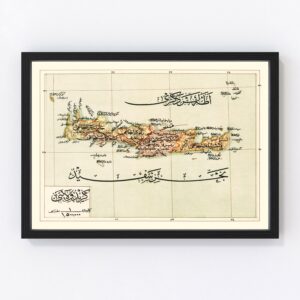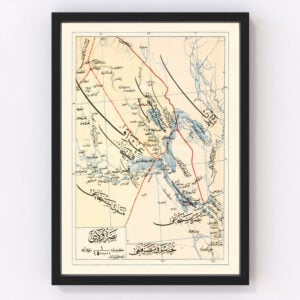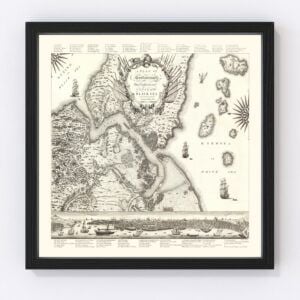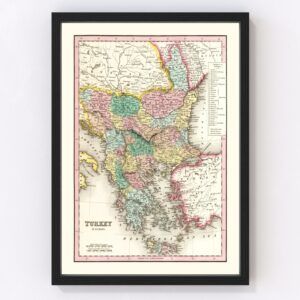Old Maps of Turkey
Take a look through our archives of Old Maps of Turkey.
Turkey is a transcontinental country located on both the Anatolian Peninsula in Asia and the Balkan Peninsula in southeast Europe. The country is one of the world’s earliest permanent settled areas. Turkey’s capital is Ankara, but the largest city is Istanbul, which also serves as the country’s financial center. The current population estimate of the country is 84,680,273 inhabitants, and the country spans a total land area of 783,365 square kilometers, or 302,535 square miles. Turkey is a part of several political groups, such as the United Nations, NATO, the IMF, and the World Bank.
The country is divided into seven different regions, and they are as follows: Marmara, Aegean, Black Sea, Central Anatolia, Eastern Anatolia, Southeastern Anatolia, and the Mediterranean. The highest point within Turkey is Mount Ararat, reaching an altitude of 5,137 meters, or 16,854 feet. Lake Van, the largest lake within the country, with a surface area of 3,755 square kilometers, or 1,450 square miles. The lake reaches a maximum length of 74 miles. When it comes to the climate of Turkey, it is continental near the coasts and temperate elsewhere. There are also plenty of hot, drier parts of the land as well.The large amounts of habitat and ecosystem diversity causes for great amounts of species diversity as well. There is believed to be over 80,000 animal species that can be found within Turkey. Commonly found animals within wooded areas include wolves, foxes, boars, wildcats, beavers, martens, jackals, hyenas, bears, deer, gazelles, as well as mountain goats. Some examples of the domesticated animals of Turkey are horses, donkeys, cattle, sheep, the Angora cat, rabbit and goat, and the national dog breeds of Kangal, Malakisi, and Akbaş.
With a newly industrialized economy, Turkey is one of the Emerging 7 countries economically. By nominal GDP, Turkey’s economy is the world’s twentieth largest by GDP, and is also the eleventh largest by PPP. Turkey is the world's 14th largest automobile producer, creating over 1.3 million motor vehicles in 2015. Some of the key sectors of the economy include banking, construction, home appliances, electronics, textiles, oil refining, petrochemical products, food, mining, iron and steel, and the machine industry. The most popular exports to come from the country are cars, delivery trucks, refined petroleum, jewelry, non-knit women’s suits, insulated wire, buses, and vehicle parts.
Turkey has a heavily urban population, with three quarters of the country’s entire population living in cities and towns. The top five largest cities within Turkey are Istanbul, Ankara, Izmir, Bursa, and Adana. It is estimated that there are 47 different ethnic groups living within Turkey, with Kurds representing the largest non-Turkish group. Prior to the Syrian war starting in 2011, it was estimated that anywhere from 1 million to 2 million Arabs lived in Turkey. In 2020, there were 3.6 million Syrian refugees living within Turkey. Of the many population groups, the 15-64 age range makes up the largest part of the population, constituting 67.4% of the entire population.
























Old Maps of Turkey
Take a look through our archives of Old Maps of Turkey.
Turkey is a transcontinental country located on both the Anatolian Peninsula in Asia and the Balkan Peninsula in southeast Europe. The country is one of the world’s earliest permanent settled areas. Turkey’s capital is Ankara, but the largest city is Istanbul, which also serves as the country’s financial center. The current population estimate of the country is 84,680,273 inhabitants, and the country spans a total land area of 783,365 square kilometers, or 302,535 square miles. Turkey is a part of several political groups, such as the United Nations, NATO, the IMF, and the World Bank.
The country is divided into seven different regions, and they are as follows: Marmara, Aegean, Black Sea, Central Anatolia, Eastern Anatolia, Southeastern Anatolia, and the Mediterranean. The highest point within Turkey is Mount Ararat, reaching an altitude of 5,137 meters, or 16,854 feet. Lake Van, the largest lake within the country, with a surface area of 3,755 square kilometers, or 1,450 square miles. The lake reaches a maximum length of 74 miles. When it comes to the climate of Turkey, it is continental near the coasts and temperate elsewhere. There are also plenty of hot, drier parts of the land as well.The large amounts of habitat and ecosystem diversity causes for great amounts of species diversity as well. There is believed to be over 80,000 animal species that can be found within Turkey. Commonly found animals within wooded areas include wolves, foxes, boars, wildcats, beavers, martens, jackals, hyenas, bears, deer, gazelles, as well as mountain goats. Some examples of the domesticated animals of Turkey are horses, donkeys, cattle, sheep, the Angora cat, rabbit and goat, and the national dog breeds of Kangal, Malakisi, and Akbaş.
With a newly industrialized economy, Turkey is one of the Emerging 7 countries economically. By nominal GDP, Turkey’s economy is the world’s twentieth largest by GDP, and is also the eleventh largest by PPP. Turkey is the world's 14th largest automobile producer, creating over 1.3 million motor vehicles in 2015. Some of the key sectors of the economy include banking, construction, home appliances, electronics, textiles, oil refining, petrochemical products, food, mining, iron and steel, and the machine industry. The most popular exports to come from the country are cars, delivery trucks, refined petroleum, jewelry, non-knit women’s suits, insulated wire, buses, and vehicle parts.
Turkey has a heavily urban population, with three quarters of the country’s entire population living in cities and towns. The top five largest cities within Turkey are Istanbul, Ankara, Izmir, Bursa, and Adana. It is estimated that there are 47 different ethnic groups living within Turkey, with Kurds representing the largest non-Turkish group. Prior to the Syrian war starting in 2011, it was estimated that anywhere from 1 million to 2 million Arabs lived in Turkey. In 2020, there were 3.6 million Syrian refugees living within Turkey. Of the many population groups, the 15-64 age range makes up the largest part of the population, constituting 67.4% of the entire population.
